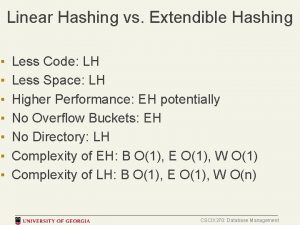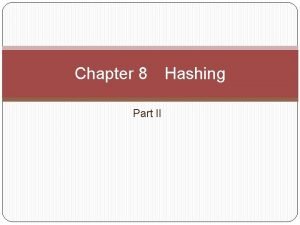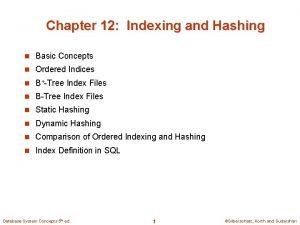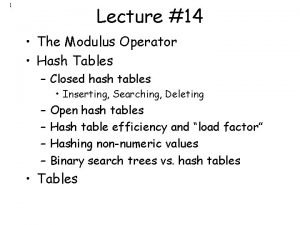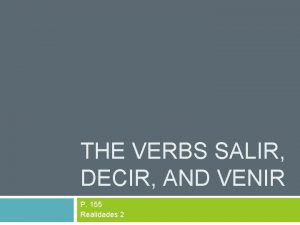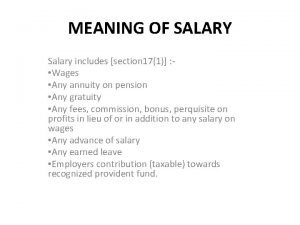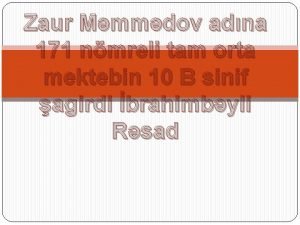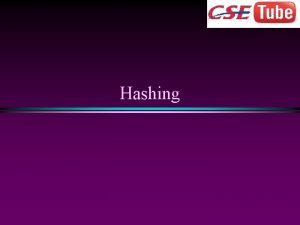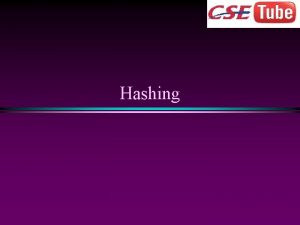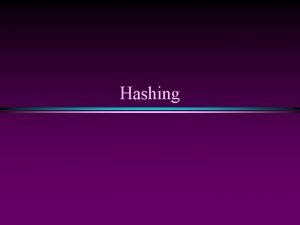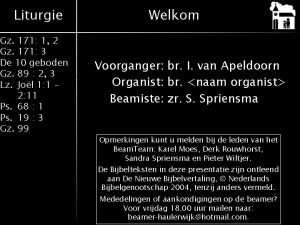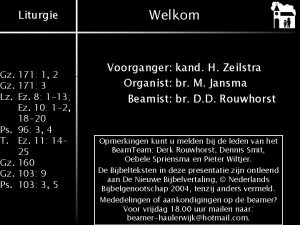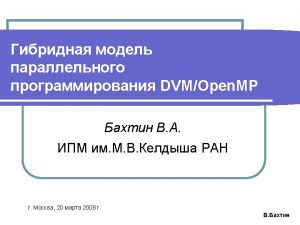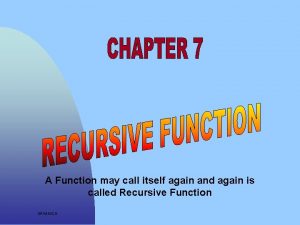COMP 171 Hashing Hashing 2 Hashing Again a




























- Slides: 28

COMP 171 Hashing

Hashing 2 Hashing … * * Again, a (dynamic) set of elements in which we do ‘search’, ‘insert’, and ‘delete’ n n Linear ones: lists, stacks, queues, … Nonlinear ones: trees, graphs (relations between elements are explicit) n Now for the case ‘relation is not important’, but want to be ‘efficient’ for searching (like in a dictionary)! Generalizing an ordinary array, n n * direct addressing! An array is a direct-address table A set of N keys, compute the index, then use an array of size N n Key k at k -> direct address, now key k at h(k) -> hashing * Basic operation is in O(1)! * To ‘hash’ (is to ‘chop into pieces’ or to ‘mince’), is to make a ‘map’ or a ‘transform’ …

Hashing 3 Hash Table * Hash table is a data structure that support n * The implementation of hash tables is called hashing n * Finds, insertions, deletions (deletions may be unnecessary in some applications) A technique which allows the executions of above operations in constant average time Tree operations that requires any ordering information among elements are not supported find. Min and find. Max n Successor and predecessor n Report data within a given range n List out the data in order n

Hashing 4 General Idea * The ideal hash table data structure is an array of some fixed size, containing the items * A search is performed based on key * Each key is mapped into some position in the range 0 to Table. Size-1 * The mapping is called hash function Data item A hash table

Hashing 5 Unrealistic Solution * Each position (slot) corresponds to a key in the universe of keys T[k] corresponds to an element with key k n If the set contains no element with key k, then T[k]=NULL n

Hashing 6 Unrealistic Solution * Insertion, deletion and finds all take O(1) (worst-case) time * Problem: waste too much space if the universe is too large compared with the actual number of elements to be stored n E. g. student IDs are 8 -digit integers, so the universe size is 108, but we only have about 7000 students

Hashing 7 Hashing Usually, m << N h(Ki) = an integer in [0, …, m-1] called the hash value of Ki The keys are assumed to be natural numbers, if they are not, they can always be converted or interpreted in natural numbers.

Hashing 8 Example Applications * Compilers use hash tables (symbol table) to keep track of declared variables. * On-line spell checkers. After prehashing the entire dictionary, one can check each word in constant time and print out the misspelled word in order of their appearance in the document. * Useful in applications when the input keys come in sorted order. This is a bad case for binary search tree. AVL tree and B+-tree are harder to implement and they are not necessarily more efficient.

Hashing 9 Hash Function * With hashing, an element of key k is stored in T[h(k)] * h: hash function maps the universe U of keys into the slots of a hash table T[0, 1, . . . , m-1] n an element of key k hashes to slot h(k) n h(k) is the hash value of key k n

Hashing 10 Collision * Problem: collision two keys may hash to the same slot n can we ensure that any two distinct keys get different cells? n 1 No, Ø if N>m, where m is the size of the hash table Task 1: Design a good hash function that is fast to compute and n can minimize the number of collisions n Ø Task 2: Design a method to resolve the collisions when they occur

Hashing 11 Design Hash Function * A simple and reasonable strategy: h(k) = k mod m e. g. m=12, k=100, h(k)=4 n Requires only a single division operation (quite fast) n * Certain values of m should be avoided e. g. if m=2 p, then h(k) is just the p lowest-order bits of k; the hash function does not depend on all the bits n Similarly, if the keys are decimal numbers, should not set m to be a power of 10 n * It’s a good practice to set the table size m to be a prime number * Good values for m: primes not too close to exact powers of 2 n e. g. the hash table is to hold 2000 numbers, and we don’t mind an average of 3 numbers being hashed to the same entry 1 choose m=701

Hashing 12 Deal with String-type Keys Can the keys be strings? * Most hash functions assume that the keys are natural numbers * n * if keys are not natural numbers, a way must be found to interpret them as natural numbers Method 1: Add up the ASCII values of the characters in the string n Problems: 1 Different permutations of the same set of characters would have the same hash value 1 If the table size is large, the keys are not distribute well. e. g. Suppose m=10007 and all the keys are eight or fewer characters long. Since ASCII value <= 127, the hash function can only assume values between 0 and 127*8=1016

Hashing 13 * Method 2 a, …, z and space 272 If the first 3 characters are random and the table size is 10, 0007 => a reasonably equitable distribution n Problem n 1 English is not random 1 Only 28 percent of the table can actually be hashed to (assuming a table size of 10, 007) * Method 3 computes n involves all characters in the key and be expected to distribute well n

Hashing 14 * Collision Handling: (1) Separate Chaining Like ‘equivalent classes’ or clock numbers in math Instead of a hash table, we use a table of linked list * keep a linked list of keys that hash to the same value * Keys: Set of squares Hash function: h(K) = K mod 10

Hashing 15 Separate Chaining Operations * To insert a key K Compute h(K) to determine which list to traverse n If T[h(K)] contains a null pointer, initiatize this entry to point to a linked list that contains K alone. n If T[h(K)] is a non-empty list, we add K at the beginning of this list. n * To n delete a key K compute h(K), then search for K within the list at T[h(K)]. Delete K if it is found.

Hashing 16 Separate Chaining Features * Assume that we will be storing n keys. Then we should make m the next larger prime number. If the hash function works well, the number of keys in each linked list will be a small constant. * Therefore, we expect that each search, insertion, and deletion can be done in constant time. * Disadvantage: Memory allocation in linked list manipulation will slow down the program. * Advantage: deletion is easy.

Collision Handling: (2) Open Addressing Hashing 17 * Instead of following pointers, compute the sequence of slots to be examined * Open addressing: relocate the key K to be inserted if it collides with an existing key. n * Two issues arise n n * We store K at an entry different from T[h(K)]. what is the relocation scheme? how to search for K later? Three common methods for resolving a collision in open addressing n n n Linear probing Quadratic probing Double hashing

Hashing 18 Open Addressing Strategy * To insert a key K, compute h 0(K). If T[h 0(K)] is empty, insert it there. If collision occurs, probe alternative cell h 1(K), h 2(K), . . until an empty cell is found. * hi(K) n = (hash(K) + f(i)) mod m, with f(0) = 0 f: collision resolution strategy

Hashing 19 Linear Probing * f(i) =i cells are probed sequentially (with wrap-around) n hi(K) = (hash(K) + i) mod m n * Insertion: Let K be the new key to be inserted, compute hash(K) n For i = 0 to m-1 n 1 compute L = ( hash(K) + I ) mod m 1 T[L] is empty, then we put K there and stop. n If we cannot find an empty entry to put K, it means that the table is full and we should report an error.

Hashing 20 Linear Probing Example * hi(K) = (hash(K) + i) mod m * E. g, inserting keys 89, 18, 49, 58, 69 with hash(K)=K mod 10 To insert 58, probe T[8], T[9], T[0], T[1] To insert 69, probe T[9], T[0], T[1], T[2]

Hashing 21 Primary Clustering * We call a block of contiguously occupied table entries a cluster * On the average, when we insert a new key K, we may hit the middle of a cluster. Therefore, the time to insert K would be proportional to half the size of a cluster. That is, the larger the cluster, the slower the performance. * Linear probing has the following disadvantages: n Once h(K) falls into a cluster, this cluster will definitely grow in size by one. Thus, this may worsen the performance of insertion in the future. n If two clusters are only separated by one entry, then inserting one key into a cluster can merge the two clusters together. Thus, the cluster size can increase drastically by a single insertion. This means that the performance of insertion can deteriorate drastically after a single insertion. n Large clusters are easy targets for collisions.

Hashing 22 Quadratic Probing Example * f(i) = i 2 * hi(K) = ( hash(K) + i 2 ) mod m * E. g. , inserting keys 89, 18, 49, 58, 69 with hash(K) = K mod 10 To insert 58, probe T[8], T[9], T[(8+4) mod 10] To insert 69, probe T[9], T[(9+1) mod 10], T[(9+4) mod 10]

Hashing 23 Quadratic Probing * Two keys with different home positions will have different probe sequences e. g. m=101, h(k 1)=30, h(k 2)=29 n probe sequence for k 1: 30, 30+1, 30+4, 30+9 n probe sequence for k 2: 29, 29+1, 29+4, 29+9 n * If the table size is prime, then a new key can always be inserted if the table is at least half empty (see proof in text book) * Secondary clustering Keys that hash to the same home position will probe the same alternative cells n Simulation results suggest that it generally causes less than an extra half probe per search n To avoid secondary clustering, the probe sequence need to be a function of the original key value, not the home position n

Hashing 24 Double Hashing * To alleviate the problem of clustering, the sequence of probes for a key should be independent of its primary position => use two hash functions: hash() and hash 2() * f(i) = i * hash 2(K) n E. g. hash 2(K) = R - (K mod R), with R is a prime smaller than m

Hashing 25 Double Hashing Example * * * hi(K) = ( hash(K) + f(i) ) mod m; hash(K) = K mod m f(i) = i * hash 2(K); hash 2(K) = R - (K mod R), Example: m=10, R = 7 and insert keys 89, 18, 49, 58, 69 To insert 49, hash 2(49)=7, 2 nd probe is T[(9+7) mod 10] To insert 58, hash 2(58)=5, 2 nd probe is T[(8+5) mod 10] To insert 69, hash 2(69)=1, 2 nd probe is T[(9+1) mod 10]

Hashing 26 Choice of hash 2() * Hash 2() must never evaluate to zero * For any key K, hash 2(K) must be relatively prime to the table size m. Otherwise, we will only be able to examine a fraction of the table entries. n E. g. , if hash(K) = 0 and hash 2(K) = m/2, then we can only examine the entries T[0], T[m/2], and nothing else! * One solution is to make m prime, and choose R to be a prime smaller than m, and set hash 2(K) = R – (K mod R) * Quadratic probing, however, does not require the use of a second hash function n likely to be simpler and faster in practice

Hashing 27 Deletion in Open Addressing * Actual deletion cannot be performed in open addressing hash tables n * otherwise this will isolate records further down the probe sequence Solution: Add an extra bit to each table entry, and mark a deleted slot by storing a special value DELETED (tombstone) or it’s called ‘lazy deletion’.

Hashing 28 Re-hashing If the table is full * Double the size and re-hash everything with a new hashing function *
 Raise and rise again until lambs become lions
Raise and rise again until lambs become lions Signposts in the outsiders
Signposts in the outsiders Crickwing read aloud
Crickwing read aloud Alliteration in song adalah
Alliteration in song adalah Distinguish between extendible and linear hashing
Distinguish between extendible and linear hashing Static hashing and dynamic hashing
Static hashing and dynamic hashing Static hashing and dynamic hashing
Static hashing and dynamic hashing Modulo function c++
Modulo function c++ Cs 171 uci
Cs 171 uci Ai 171
Ai 171 171 nomreli mekteb
171 nomreli mekteb Lei 171 de 2007
Lei 171 de 2007 171 in binary
171 in binary Ai 171
Ai 171 Decret 171/2015
Decret 171/2015 What do salir decir and venir have in common
What do salir decir and venir have in common 171 sayli mekteb
171 sayli mekteb 171 meaning
171 meaning Hazardous material table
Hazardous material table Nonlinear pricing strategies
Nonlinear pricing strategies 171 sayli mekteb
171 sayli mekteb 171 nomreli mekteb
171 nomreli mekteb Pg 171
Pg 171 Meeting jesus again for the first time
Meeting jesus again for the first time Can the dust bowl happen again
Can the dust bowl happen again Mini sagas
Mini sagas Surprised jesus
Surprised jesus Social adjustment examples
Social adjustment examples On sitting down to read king lear
On sitting down to read king lear




